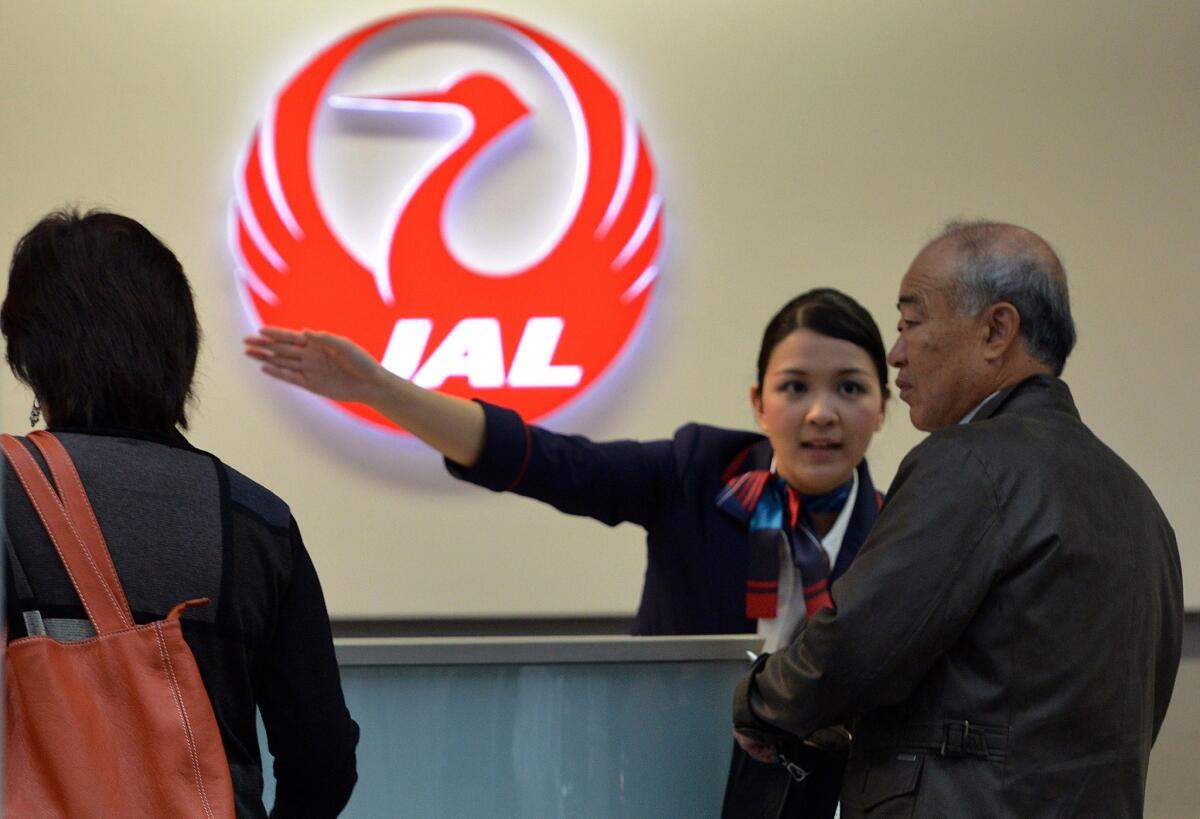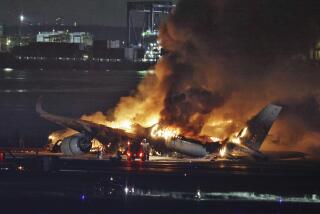Airline passengers at front lines of dispute over China air zone

TOKYO -- Although she is a seasoned traveler who frequently flies the route between Tokyo and Hong Kong, Kazuyo Ito confessed to some preflight anxiety as she checked in Thursday for Japan Airlines Flight 29.
“It is a little scary,” said the 59-year-old housewife, when asked about China’s threat to stop aircraft that refuse to identify themselves when flying through a large swath of the East China Sea.
FOR THE RECORD:
China air defense: An article in the Dec. 5 A section referred to a travel agency sales director as Koki Nakamori. Nakamori’s first name is Koji.
The situation in effect puts ordinary airline passengers at the front lines of the dispute over China’s declaration of an air defense identification zone over islands Japan administers.
“They wouldn’t do something to a commercial airline,” Ito said uncertainly, before turning to her 29-year-old daughter, Kaori, who piped in with more confidence, “I don’t think it will affect regular passengers like us.”
Under the rules announced by Beijing in a Nov. 23 declaration, all aircraft passing through the zone must file their flight plans in advance and maintain two-way radio communication during the flight.
Japan Airlines and All Nippon Airways, the leading Japanese carriers, initially promised to comply but reversed themselves two days later on orders of Japanese Prime Minster Shinzo Abe.
“It was the government’s decision, not the airlines,” said Geoffrey Tudor, a senior analyst with Japan Aviation Management Research in Tokyo. “The Japanese, being obedient, followed the government’s line. They couldn’t really say no coming from the government at such a high level.”
The Japanese decision has drawn widespread criticism, with one Hong Kong-based Chinese newspaper declaring it to be “tantamount to using passengers as human shields.”
“Politics are politics. Let the diplomats work it out. If there are in-flight games of chicken, let the military pilots handle those,” said Henry Harteveldt, a San Francisco-based travel analyst. “Airlines are supposed to be nonpolitical and to operate out of an abundance of caution for the safety of their passengers, crew and equipment.”
The biggest fear, he said, is another incident like the 1983 downing of Korean Airlines flight 007, which was mistaken for a spy plane when it veered into Soviet territory and was shot down.
The U.S. government, while refusing to recognize the Chinese zone, has in essence told American carriers they should nevertheless file their flight plans in advance with China.
The differing responses have caused discomfort in the U.S.-Japan relationship and subjected the Obama administration to accusations of capitulating to China.
“Obama throws Japan under the bus and bows to China,” was the headline on an editorial earlier this week in Investor’s Business Daily.
The dispute over the Chinese zone has dominated a visit to the region by U.S. Vice President Joseph Biden, who met with Abe in Tokyo earlier in the week and with Chinese President Xi Jinping in Beijing on Wednesday. Biden was heading Thursday to Seoul to meet with South Korean President Park Geun-hye.
“China’s recent and sudden announcement of the establishment of a new air defense identification zone has, to state the obvious, caused significant apprehension in the region,” Biden said Thursday, addressing the U.S. Chamber of Commerce in Beijing.
Although Biden stopped short of asking the Chinese to rescind the designation of the zone, he did ask them to lower tensions by “avoiding enforcement actions that really could lead to a crisis,” a senior administration official told reporters Wednesday in Beijing.
Under the rules originally announced by Beijing, its military would be entitled to take “emergency defensive measures” against unidentified aircraft flying through the zone -- an implicit threat that they could be shot down. In recent days, however, Chinese officials have backed away from the tougher language and emphasized that the zone is designed as a safety measure.
Roughly 30 Japanese carriers operate flights that regularly pass through the zone, mostly on routes from Japan to Taiwan and Hong Kong, as well as to Southeast Asia.
The Japanese airlines have not disclosed how the dispute has impacted their ticket sales.
Koki Nakamori, sales director at a travel agency specializing on travel to Taiwan, said that a high school group planning to fly 125 people next week to Taipei had canceled.
“This was a school, so I think they may have been a little more sensitive than others,” said Nakamori. “We’re getting almost no cancellations with individual travel plans.”
At Tokyo’s Haneda airport on Thursday, many travelers said they were unaware of whether their flights were passing through the Chinese zone or didn’t care.
“I support the Japanese government’s position not to submit flight plans to China,” said Naomasa Nakamura, a 55-year-old office worker heading for Hong Kong on All Nippon Airways. “I don’t think they [China] will do anything brash.”
The Chinese air defense identification zone covers much of the East China Sea, including the disputed Japanese-administered islands known as Senkaku to the Japanese and Diaoyu to the Chinese. It also includes reefs known as Ieodo that are under South Korean control.
The South Korean defense ministry on Monday announced that its airlines should not file advance notices when flying through the zone.
The United States has tried to finesse the issue, appearing to defend its key Asian allies – Japan and South Korea – while not putting passengers at risk. Days after the Chinese announced the air defense identification zone, the Pentagon flew two B-52 bombers through to signal their defiance of the announcement.
A senior administration official briefing traveling reporters during the Biden trip this week said the U.S. Federal Aviation Administration had not issued formal guidance on the issue, but reiterated “long-standing practice that for the safety and security for passengers, U.S. civilian airlines operate consistent with NOTAMs the world over.” The term refers to notices to airmen, alerts to notify pilots of hazards along their routes.
“There is fundamentally no daylight between us” and Japan, the official added.
Tokyo-based travel analyst Tudor said he thought the main difference was that the Japanese are less inclined to sue.
“The United States is a more litigious society than Japan, and government agencies are sensitive about the possibility of illegalities,” he said.
ALSO:
American teacher is shot and killed in Libya
Yemen attack bears hallmarks of Al Qaeda; at least 47 dead
Karzai accuses U.S. of civilian deaths in November drone strike
Twitter: @BarbaraDemick
Staff writer Demick reported from Beijing and special correspondent Nagano from Tokyo.
More to Read
Start your day right
Sign up for Essential California for news, features and recommendations from the L.A. Times and beyond in your inbox six days a week.
You may occasionally receive promotional content from the Los Angeles Times.






